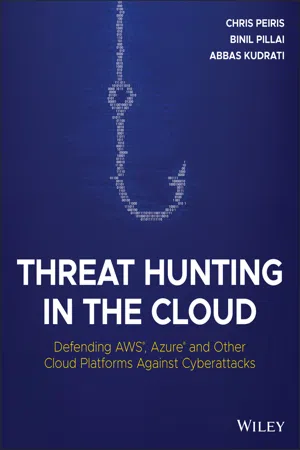
Threat Hunting in the Cloud
Defending AWS, Azure and Other Cloud Platforms Against Cyberattacks
- English
- ePUB (mobile friendly)
- Available on iOS & Android
Threat Hunting in the Cloud
Defending AWS, Azure and Other Cloud Platforms Against Cyberattacks
About this book
Implement a vendor-neutral and multi-cloud cybersecurity and risk mitigation framework with advice from seasoned threat hunting pros
In Threat Hunting in the Cloud: Defending AWS, Azure and Other Cloud Platforms Against Cyberattacks, celebrated cybersecurity professionals and authors Chris Peiris, Binil Pillai, and Abbas Kudrati leverage their decades of experience building large scale cyber fusion centers to deliver the ideal threat hunting resource for both business and technical audiences. You'll find insightful analyses of cloud platform security tools and, using the industry leading MITRE ATT&CK framework, discussions of the most common threat vectors.
You'll discover how to build a side-by-side cybersecurity fusion center on both Microsoft Azure and Amazon Web Services and deliver a multi-cloud strategy for enterprise customers. And you will find out how to create a vendor-neutral environment with rapid disaster recovery capability for maximum risk mitigation.
With this book you'll learn:
- Key business and technical drivers of cybersecurity threat hunting frameworks in today's technological environment
- Metrics available to assess threat hunting effectiveness regardless of an organization's size
- How threat hunting works with vendor-specific single cloud security offerings and on multi-cloud implementations
- A detailed analysis of key threat vectors such as email phishing, ransomware and nation state attacks
- Comprehensive AWS and Azure "how to" solutions through the lens of MITRE Threat Hunting Framework Tactics, Techniques and Procedures (TTPs)
- Azure and AWS risk mitigation strategies to combat key TTPs such as privilege escalation, credential theft, lateral movement, defend against command & control systems, and prevent data exfiltration
- Tools available on both the Azure and AWS cloud platforms which provide automated responses to attacks, and orchestrate preventative measures and recovery strategies
- Many critical components for successful adoption of multi-cloud threat hunting framework such as Threat Hunting Maturity Model, Zero Trust Computing, Human Elements of Threat Hunting, Integration of Threat Hunting with Security Operation Centers (SOCs) and Cyber Fusion Centers
- The Future of Threat Hunting with the advances in Artificial Intelligence, Machine Learning, Quantum Computing and the proliferation of IoT devices.
Perfect for technical executives (i.e., CTO, CISO), technical managers, architects, system admins and consultants with hands-on responsibility for cloud platforms, Threat Hunting in the Cloud is also an indispensable guide for business executives (i.e., CFO, COO CEO, board members) and managers who need to understand their organization's cybersecurity risk framework and mitigation strategy.
Frequently asked questions
- Essential is ideal for learners and professionals who enjoy exploring a wide range of subjects. Access the Essential Library with 800,000+ trusted titles and best-sellers across business, personal growth, and the humanities. Includes unlimited reading time and Standard Read Aloud voice.
- Complete: Perfect for advanced learners and researchers needing full, unrestricted access. Unlock 1.4M+ books across hundreds of subjects, including academic and specialized titles. The Complete Plan also includes advanced features like Premium Read Aloud and Research Assistant.
Please note we cannot support devices running on iOS 13 and Android 7 or earlier. Learn more about using the app.
Information
Part I
Threat Hunting Frameworks
In This Part
- Chapter 1: Introduction to Threat HuntingChapter 2: Modern Approach to Multi-Cloud Threat HuntingChapter 3: Exploration of MITRE Key Attack Vectors
CHAPTER 1
Introduction to Threat Hunting
What's in This Chapter
- The rise of cybercrime
- What is threat hunting?
- Key cyberthreats and threat actors
- Why is threat hunting relevant to all organizations?
- Does an organization's size matter?
- Threat modeling
- Threat hunting maturity model
- Human elements of threat hunting
- How do you make the board of directors cyber-smart?
- Threat hunting team structure
- The threat hunter's role
The Rise of Cybercrime
- The average cost of a data breach is USD 3.86 million.
- The U.S. has the most expensive data breaches.
- Healthcare is the most vulnerable industry; the average cost is USD 7.13 million.
- The average time to identify and contain a breach is 280 days.
What Is Threat Hunting?
Table of contents
- Cover
- Table of Contents
- Title Page
- Foreword
- Introduction
- Part I: Threat Hunting Frameworks
- Part II: Hunting in Microsoft Azure
- Part III: Hunting in AWS
- Part IV: The Future
- Part V: Appendices
- Index
- Copyright
- Dedication
- About the Authors
- About the Technical Editors
- Acknowledgments
- End User License Agreement